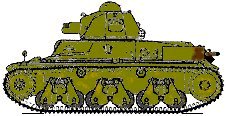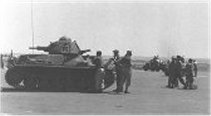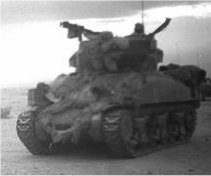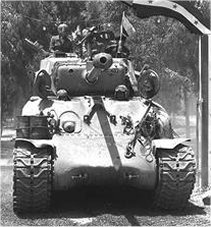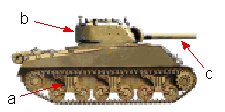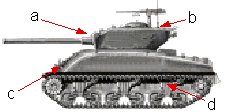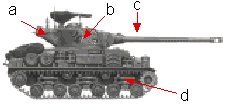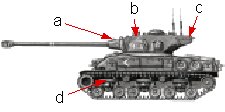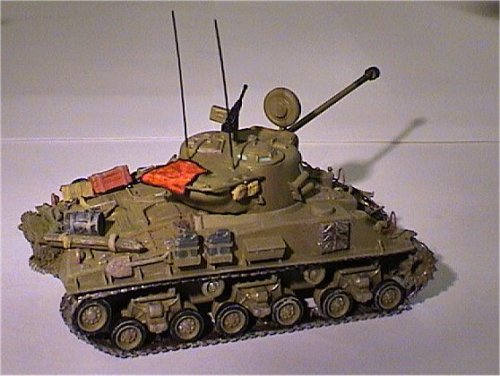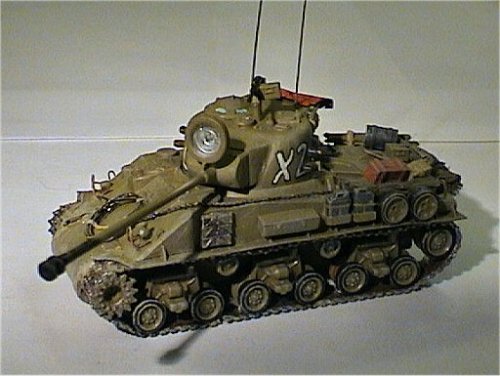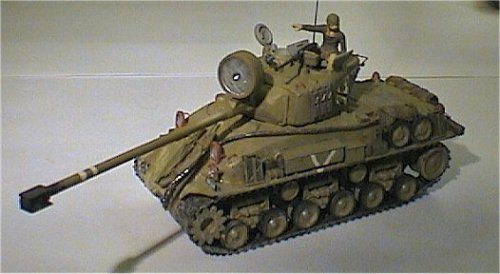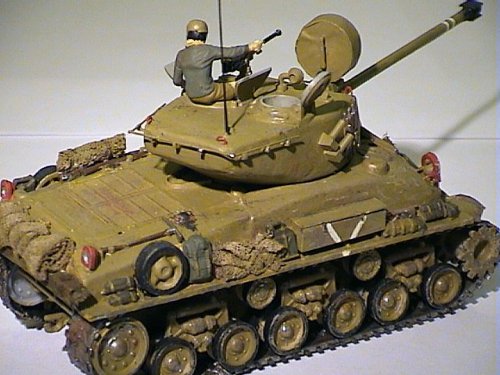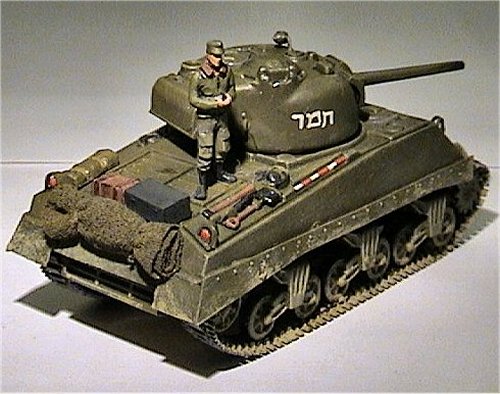In this section information is collationed on MBTs that were acquired the 'normal' way by the IDF, i.e. bought overseas or produced in-land. As the Hotchkiss tanks were mainly bought in Europe - additionally a few were captured during the War of Independence - they are included here and not in the captured Vehicles section.
All started with these tanks. Barely enough to form a tank company worthy of that description they were the nucleus of what is now one of the most powerful armoured forces in existence. They were clandestinely acquired in Europe and shipped to Israel under the label 'agricultural machinery'. Although I at first thought all of them to be H-35s, some of them apparently were H-39s. As the picture below shows, they can be discerned mainly by the length of their main gun; there are also some differences on the engine deck and the rear parts of the upper armoured body, but I know of no picture showing the engine deck of an IDF operated vehicle.
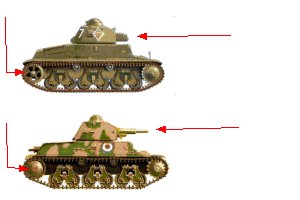
On top the H 35, below the H 39, which was effectively an upgraded version of the former (markings and camouflage are French, by the way). Note the main armament (in both cases a 37mm gun), and other differences, indicated by the red arrows (spoked wheel vs disk wheel). As far as the suspension is concerned, it seems to me (I have to be cautious, as I'm not an expert on French tanks) that the suspension parts between the two models were at least to some extent interchangeable - you can find pictures of H 35s with disk wheels etc.
Although the longer-barrelled 37mm gun was quite a good weapon (at least for the size of the tank and the late 1930s, when the tank was designed), the tank commander, who had to handle the gun, the radio equipment - and the task of commanding the tank, of course - was definitely overtasked in the two-man tank. Moreover, if it was his job, too, to command not only his own, but also other tanks as well, he must be considered hopelessly overworked!
This picture shows one of them, a H 39 to be precise. It was made during the occupation of Lydda airport or shortly afterwards, as the whole scene seems to be rather peaceful. Most of the (admittedly rather few) pictures I have been taken during this incident.
These tanks were almost exclusively used in the infantry support role, and in that they were not very effective, not the least due to the fact that combined arms was an art the IDF had yet to learn in 1948.
Above a H 35 tank used in the capture of Lydda airport. The green should perhaps be slightly darker. By the way, all profiles and drawings you find on these pages were 1/72 scale when I scanned them in - however, I don't know what happens when you print them, so if you want to use them, check about that.
H 35/39 w. 2pdr
There are rumours that the Syrians mounted a 2pdr gun in some of their Hotchkiss tanks. Indeed on the Sentinel page you can find one picture of such a conversion; however, I wasn't able to produce any reliable information beyond that picture.
Modelling?
There is no plastic kit of the H 35/39 known to me. What makes scratchbuilding rather tricky is the fact that most parts on the original vehicles are cast, making a lot of shaping and sanding necessary. I must admit I haven't tried it, perhaps laminating and sanding to form is the thing to do here.
Let's continue with an overview over the Sherman variants used by the IDF. I said I'm not S. Paine; I'm not R. Hunnicutt either, so if you want detailed information on everything concerned with the Sherman tank, consult his Sherman 'bible'. Moreover, detailed information on Israeli Shermans can be found in the definite work on that topic - T. Gannon's "Israeli Shermans". What you cannot find in there is not important!
The Beginnings
On the Shermans operated by the IDF during the War of Independence, cf. the captured Vehicles section. Apart from the vehicles acquired during the war, other tanks were bought - partly from scrap merchants - immediately after the war. In total, around two companies were on strenght in 1950, most of them armed with old Krupp 75mm howitzers of WWI vintage - which had at least questionable value against anything but infantry targets. Others were armed with 75mm M 3 guns of American origin, but lacking sufficient ammunition. There was even one Firefly without any ammunition for its 17pdr gun. After further acquisitions from the Philippines, a total of four companies with 17 tanks each could be fielded. All tanks seem to have been equipped with VVSS.
Just as an example we have here a cast-hull VVSS Sherman employed during the Sinai campaign. This tank appears to have an old turret, probably mounting a 75mm gun.
The French move
As the French policy towards Israel underwent a maior change, France agreed in 1956 to provide Israel with around 250 tanks, AMX-13 light tanks as well as the so-called 'Supershermans'. These were mainly M4A1 tanks, many with HVSS, equipped with 76.2mm guns. The tanks were transferred to Israel in a clandestine operation lasting for several weeks, being ferried by three LST's directly to beaches in Israel. They arrived just in time for use during Operation Kadesh. For the AMX-13 tanks see below.
Even more interesting is this picture. It shows a Sherman employed in the 1967 war on the northern front. This particular vehicles has a cast hull, HVSS and a T23 turret still mounting the original 76mm gun, making it most probably a reserve unit tank.
Upgunning the Sherman
As the armies of most of Israel's neighbours were reequipped with Soviet weaponry during the early 1950s, the Sherman tanks were rapidly outclassed, being insufficiently armed for dealing with T 34/85s or JS-3 heavy tanks. The urgent need to improve the main armament of the Sherman arose. The situation was quite comparable to that which led to the development of the Firefly tank during the latter part of WWII. In short, a gun capable of defeating most if not any enemy armour was needed.
The CN 75-50 gun
This gun proved to be the solution to the problem of defeating most Soviet armour then in use. Quite ironically, it had its roots with a German WWII weapon, the legendary 75mm KwK 42 L/70 gun, which was probably the best tank gun of the war. The French had developed this gun, boasting already a muzzle velocity of over 900 m/sec, into the CN 75-50 gun with 1000 m/sec. It was considered to be the best tank gun at the time and fitted e.g. to the AMX-13 light tank. Since 1954 Israeli and French experts tried to mate this gun to the Sherman at the Bourges Arsenal in France. Several problems were encountered, but in the end two solutions were tested: a M-10 with the new gun mounted in the open-topped turret and a conventional Sherman turret with the gun mounted in the turret. After the decision for the closed-turreted solution was made, the prototype turret was sent to Israel late in 1955.
The Sherman M-50
The first Supershermans (upgunned with a French 75mm gun) that were acquired in the early 50s still had VVSS. Most of these early M-50s seem to have been of the M4a4 variant. By 1966 all of the M-50 tanks seems to have been upgraded to HVSS, among of them not only M4a4s, but also many M4a1s with cast hulls.
Above you can see on the left an early M-50, still equipped with VVSS, whereas the M-50 on the right has HVSS.
Even more firepower - the CN 105 D 1 L/44 gun
As the CN 75-50 gun was originally designed to defeat T-34/85 tanks, the appearance of T-54/55 tanks with Arab armies left the Israeli Shermans rather undergunned, even though they repeatedly proved to be able to stand against T-54/55s. Nonetheless, more firepower was deemed to be necessary. Thus again the Israelis looked towards the French armament industry. In France, a new tank gun had just been developed for the future French MBT (what would eventually become the AMX 30), the CN 105 F 1. This was a 56 calibre (a staggering six meters long) rifled gun, firing a HEAT round with a muzzle velocity of around 1000 m/sec. However, this gun could definitely not be installed in a Sherman turret, as this offered not enough recoil space. The Israelis then came up with a solution of their own: By shortening the gun to a 44 calibre gun (about 1.4 meters shorter than the original design) and by accepting a lower muzzle velocity of around 800 m/sec. this modification, called the CN 105 D 1 gun, could indeed be crammed into a T 23 turret.
The Sherman M-51
The result was the mightiest Sherman ever produced - the Sherman M 51. Almost all of them were based on cast hulls, all fitted with modern diesel engines and HVSS. The most obvious feature - apart from the huge gun, of course - was the large muzzle brake to reduce the shock resulting from firing the gun. These tanks were still in use during the 1973 war and were able to deal with Syrian T-62s.
Sherman variants compared
To give an impression of the differences between the Sherman variants operated by the IDF here some side elevations - they are not to scale!!. As they are only for a first impression, they are farely crude. More detailed plans will be available here, when I have found the time to come up with them...
As an example for the first Shermans used by the IDF there is a M4a3 on the left with VVSS (a), an old turret (b) mounting a 75mm gun (c). Compare this to the M4a1 on the right with cast hull (c), T23 turret (b) with commander's cupola and 76mm gun (a). This tank too has VVSS (d).
Further down the line of Sherman development, on the left there is a late M-50 with HVSS (d). Note the old turret (b) with counterweight (a) welded on and the 75mm gun (c). On the right a M-51. Note HVSS (d), T23 turret (b) with commander's cupola, counterweight (c) and redesigned turret front to fit the 105mm gun (a).
Modelling the Sherman
Now let's take a look at the kits that are offered on the market.
Airfix Sherman + Heller Sherman
This is actually one and the same kit of a welded-hull Sherman with VVSS, probably a M4. It scales out roughly to 1/76, it might be even slightly smaller - don't care about what is written on the box, as cardboard is supposed to be patient... The hull is about right, the turret however is too small. The suspension is not that detailed (eg the wheels being detailed only on one side) and I have sincere doubts on some details (eg the transmission cover), but it's cheap and readily availible.
There's quite a lot of conversion potential in the kit - almost any of the VVSS Shermans the IDF used can be built excluding only the M-50 based on the M4a4. The conversions should also be rather easy, with getting enough reference for the early variants being probably a greater problem.
If you want to set out on a more difficult project it's possible to change the VVSS for a HVSS. This can be taken either from the Fujimi kit (see below) or the Matchbox M40 (see below as well). Taking it from the Fujimi kit is easier - much easier; the M40 is only an alternatíve when you are among the poor fellows who don't have access to Fujimi kits (like me...), as you have to shorten it.
Also the kit can be used to build some Sherman derivatives that are described in the other sections of the list. Further remarks can be found there.
Italeri/Esci Shermans
These are really classics. Although they are collector's items by now, I have them included as they were stunning kits - and I had to include Esci's Merkava. The M4a1 has now been rereleased by Italeri, and no doubt we will see the M4a3 soon.
The M4a3 was probably one of the best 1/72 tank kits ever made. It is very accurate, detail is crisp and for a change we have plastic tracks (link-and-length system).
The M4a1 was of the same quality, although there is some debate on it's accuracy as the kit has a late hull but an old turret - more to that question can be found here. In any case by using the T23 turret from Revell's kit (see below) you can get a fair representation of an IDF-operated M4a1 VVSS during the fifties. By using Hasegawa's HVSS, it should be not too difficult to build all the other Sherman varaints in use with the IDF. However, bear in mind that the Hasegawa Sherman is too large for 1/72 (see below)!
Matchbox Firefly
A neat kit of a Firefly based on a M4a4 hull. It comprises a sensible parts breakdown with nice detail, although most of the latter is molded on - work for the blade methinks... As a kit it's in a league above the Airfix/Heller offering, but unfortunately as Matchbox is now defunct it is unclear whether Revell will continue this kit in their range. I have in the meantime seen it in a set together with Revells ANZAC troops, however, this is out of production now, too.
This kit almost cries out for conversion into an M-50 VVSS as you only have to change the turret. More demanding is a conversion into a tank with HVSS - you either have to shorten the M40 suspension or lengthen the suspension of the Fujimi Easy Eight. I must admit I haven't tried out the latter, but it would seem more difficult to me as you have to lengthen the tracks as well.
Above you can see what can be done with a Matchbox M4A4 'Firefly' - a M 50 HVSS during the six-days-war; suspension and commander cupola come from the Matchbox M 40 GMC kit.
Another view of the vehicle. Quite a number of small details (headguards etc.) are scratchbuilt, but I used WW2-type jerrycans, which is obviously wrong.
Matchbox M40 GMC
Again a nice Matchbox kit. If you see one in your local model shop, get it now. I don't think Revell will continue that beast in their range. It is a very useful source for HVSS suspension, even though getting it on other tanks can be quite tricky. With the cast hull and the turret of Revell's Sherman one can produce quite an acceptable M-51 - definitely better than an alternative described below...
Fujimi M4a1 and M4a3
Very nice kits (to judge from the M4a1), unfortunately hard to get where I live. Together with the Easy Eight (below) you should be able to produce most of the extant Sherman variants including the M-51. If I'm able to put my hands on some of them I will provide more information.
Hasegawa M4a3
That's the 'Easy Eight' with HVSS. Detail is rather fair and oversimplified, but the main drawback is the scale: although 1/72 is written on the box the kit is actually closer to 1/70 (or even larger than that...). I once tried to mate the lower hull to the cast upper hull of the Revell M4a1 (the following kit) to produce a M-51. DON'T DO THAT! IT'S WAY FOOLISH! Having the 1/76 hull sit on a ~1/70 suspension makes the result look slighty awkward, to say the least...
My first M 51 conversion - viewed from a distance it seems to be quite acceptable...
but looking closer there's a veeery prominent 'dent' where I had to saw the upper hull into two parts. Even if I hadn't botched this sawing-and-enlarging job, the suspension still is noticeably too large - my M-51 almost dwarfes an Esci 1/72 Merkava! Oh, and as I realized that this conversion project would be a complete dud, I didn't care a lot about further details, so I just loaded it up and built an approximation of a muzzle brake.
I have a new one in the making, this time 1/76 and based on Revell, Fujimi and Matchbox parts. We'll see how this turns out.
Revell M4a1
Now this is some kit. Again a 1/72-wannabe, although this time the lower hull and VVSS suspension (which is quite nice together with plastic link-and-length tracks) is probably really 1/72. The upper hull however is very close to 1/76 and thus a good source eg for a M-51 project (see above - way above!), but built straight from the box it looks rather strange. The turret (T23 with 76mm gun) in turn is roughly 1/72 scale, although the overall shape is rather suspect and the gun is, well, strange.
That was the Sherman story. With it ends - almost - the pleasurable part of IDF-modelling in 1/72 or 1/76, as the rest is a rather saddening story (sniff!).
As a postscript - the weasel way to build an early IDF Sherman: use a die-cast model! The Sherman above started its life as a 'Armour Collection' FFL Sherman that I picked up a few years ago at a bargain price. After some modest additions (sandshields, lights etc.) it doesn't look too bad (as long as you don't look too close at the suspension, that is). The crewman by the way is from Preiser.
Centurion
But first for something different. The IDF makes quite extensive use of the Centurion. Various modifications have been made including upgunning with an 105mm gun, fitting a new diesel engine and a reactive armour suit. reference on these modifications is plentiful, so I will leave out the details here; consulting Jane's Armour ans Artillery is always a good idea...
As far as kits are concerned the cupboard is quite bare - to my knowledge Airfix's Centurion is the only offer available. However, although this kit is quite old - and I'm still not absolutely sure which mark it originally was meant to resemble - , the conversion potential is great - I know a really, really crazy fellow who even tried to build a Merkava prototype using parts from that kit..., so all criticism aside it's there, it's dimensionally correct and it's cheap. BE HAPPY!
M 48/60 family and Merkava
Now comes the sad part - the M-48/M-60. Again the IDF makes extensive use of these vehicles, updating them in very interesting ways. Unfortunately there are no kits on the market these days. Esci produced most of the M-48 and M-60 variants, both hard to find now. Esci even produced an IDF version with a reactive armour suit, but that's a collector's item now.
The same goes for the Merkava family. Esci had both the Mk 1 and the Mk 2 in their range and excellent kits they were. Well, you could perhaps try to build an early Mk 1 using Centurion parts, as I mentioned above...
Galaxy, a Chinese manufacturer, is said to have produced some simplified copies of Esci's Merkava I and M60A3. I have yet to see one of these kits, but there are rumours that Galaxy is already defunct now.
still under construction!!

